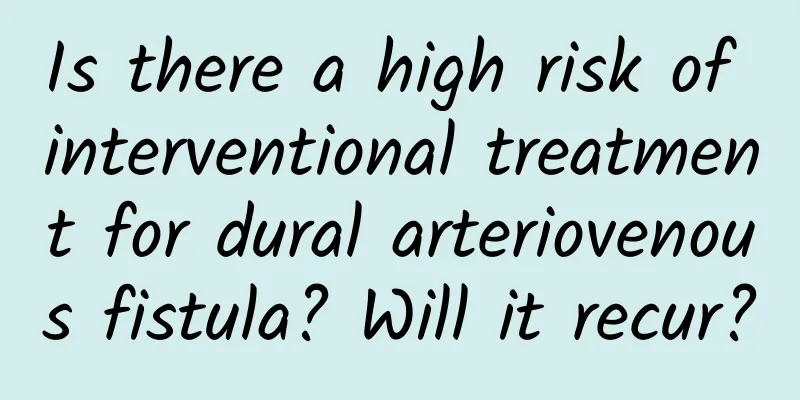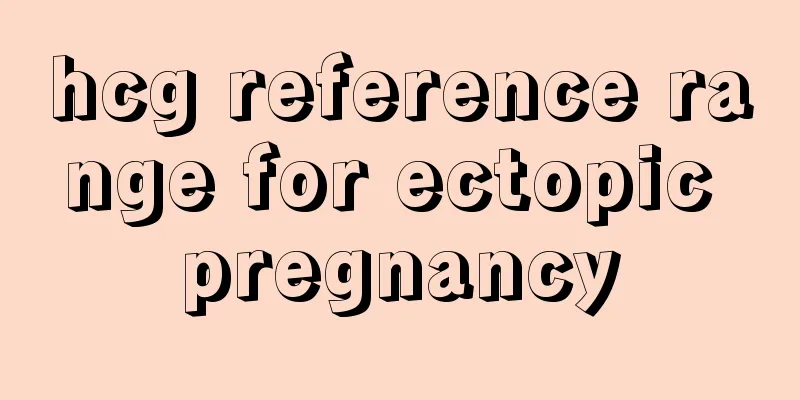Is there a high risk of interventional treatment for dural arteriovenous fistula? Will it recur?

|
Author: Jiang Chuhan, Chief Physician, Beijing Tiantan Hospital, Capital Medical University Reviewer: Xu Jun, Chief Physician, Beijing Tiantan Hospital, Capital Medical University Interventional therapy is the preferred treatment for dural arteriovenous fistula. The site of the fistula is reached through arteries, veins or direct puncture to eliminate the communication between the artery and vein. Interventional treatment of dural arteriovenous fistula is relatively safe, and most dural arteriovenous fistulas can be cured. Like any surgical operation, there are certain risks. First, bleeding. For example, when a fistula is suddenly blocked, the blood needs to be redistributed. Some blood vessels cannot bear it and will rupture. We also have a term called normal perfusion pressure breakthrough, which is like a river being blocked and the water overflows, so it will cause bleeding. To reduce this situation, embolization is performed in some cases. Although this complication is rare, it can be life-threatening if it occurs. Figure 1 Original copyright image, no permission to reprint Second, complications of ischemia. This type of ischemia is mainly venous ischemia, which is more common. For example, when closing the venous sinus fistula, the normal drainage vein is also blocked, so the normal brain tissue drainage is lost, which will cause venous ischemia. For example, if the drainage vein is in the cerebellum, causing venous ischemia in the cerebellum will cause ataxia and unsteady walking; if this venous ischemia occurs in the motor area of the brain, hemiplegia, aphasia, etc. will occur; if it is in the occipital lobe, it will cause hemianopsia; if it is in the brain stem, it will cause coma. Third, some cranial nerve symptoms may occur. When embolizing dural arteriovenous fistula, the dural artery is mainly used, and part of the dural artery supplies cranial nerves, such as the oculomotor nerve, facial nerve, glossopharyngeal nerve, hypoglossal nerve, etc. During the treatment of dural arteriovenous fistula, if the blood supply to these nerves is affected, paralysis of these nerves will occur. If the eye motor nerves such as the oculomotor nerve and the abducens nerve are affected, double vision will occur. If the facial nerve is damaged, symptoms related to facial paralysis such as inability to close the eyes may occur. After interventional treatment of dural arteriovenous fistula, the patient can usually be discharged from the hospital within 3 days. On the day of the interventional surgery, the legs should be immobilized, preferably for 24 hours. It will be safer to get out of bed after 24 hours. After discharge, the wound should not be exposed to water for one month. It can be cleaned with water after one month. Also, do not walk too much, as walking too much will easily cause hematoma in this area. Daily life and normal diet are generally not affected. In addition, for some people who have experienced neurological damage, such as oculomotor nerve palsy, they may need to take methylcobalamin for a long time. There is another point we need to remind everyone, that is, return to the hospital for a follow-up checkup 3-6 months after surgery. Figure 2 Original copyright image, no permission to reprint If the first embolization is complete, the follow-up examination will only require some non-invasive cerebrovascular examinations, such as CTA (CT angiography) or MRA (magnetic resonance angiography). If CTA or MRA does not find a fistula, no further examination is required. If a fistula is found, or if the observation is unclear, the glue or coil filling affects the judgment of the fistula, then a cerebral angiography should be performed. For those who have not been completely embolized and need to be embolized again next time, cerebral angiography will be performed directly during the follow-up examination and secondary treatment will be carried out at the same time. Interventional treatment of dural arteriovenous fistula has a certain recurrence rate, but it is not very high. For fistulas in the transverse sinus-sigmoid sinus area, it is difficult to achieve complete cure, and some of the cured cases are prone to recurrence. Therefore, dural arteriovenous fistula should be re-examined 3-6 months after treatment, in order to detect and treat these recurring cases early. If recurrence occurs, most of them can be treated with interventional therapy. However, some pathways have been destroyed during the first treatment, and the blood supply arteries are often very small after recurrence, so treatment may be difficult. However, it can still be treated according to the situation. If interventional therapy cannot be performed, gamma knife or surgical treatment can be considered. |
<<: How is dural arteriovenous fistula treated?
Recommend
How should women with poor liver function treat their condition?
The liver is an important organ for detoxificatio...
Half a month of bleeding after medical abortion
Medical abortion is a relatively common method of...
Women who drink cat's eye grass for a long time
Plants that can survive in the fields have strong...
Are QQ tacit answers sent by designated people? How to view the results of QQ tacit answers?
QQ tacit answering is a tacit question-and-answer...
Can advanced cervical cancer be cured?
Cervical cancer is divided into several different...
Treatment of bacterial vaginosis and trichomoniasis
Married women often suffer from vaginitis. With t...
How many days does a menstrual period usually take?
If a woman is healthy, her menstrual period will ...
When is the best time for women to lose weight?
Losing weight in different seasons will have a ce...
Menstruation came twice and then stopped during breastfeeding
During the breastfeeding period, menstruation com...
What are the causes of urinary tract infection in women?
Urinary tract infection is a common disease among...
What to do if your thigh hurts after a normal birth
When women give birth, except for special reasons...
What causes diarrhea during menstruation?
When women reach their menstrual period, their bo...
Pain above the breast and below the collarbone
In daily life, many people will experience pain a...
Can I have sex when I am two weeks pregnant?
If you get pregnant during intercourse, theoretic...
It is necessary to test progesterone in eight weeks of pregnancy
Progesterone is a very important thing during pre...









